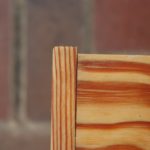Back in the early summer of 2013 I built this box to store my drawing and art supplies:

It’s the 19th-century schoolbox from The Joiner and Cabinet Maker, made with circa-1830 methods, resized and with a till for pencils. It’s functional and attractive sitting beside my desk, and the yellow pine has aged nicely, but it’s essentially a student project, without unnecessary adornment. The exposed dovetails aren’t contemporary ornament but evidence that the original wasn’t worth the effort of fancy moulding or veneer. The simple moulding around the top is simply nailed on, with historically accurate cut nails (headless brads, actually). Here’s what the top looked like when it was first built:
There’s a dab of glue at the center of the front piece and at the front end of the side pieces, but otherwise it’s just the nails holding that moulding on. To glue the moulding to the sides would invite disaster: wood, of course, expands and contracts across the grain as the ambient humidity changes, and if you force long-grained moulding to stay attached to the end grain of the top, something’s apt to break.
Novices and non-woodworkers may ask: Does wood really move that much? Moderately experienced woodworkers may ask, contrarily: Won’t those nails keep the moulding from moving laterally and invite as much damage as glue? When I first started working wood I was mildly skeptical on the first point; when I built this piece I was mildly skeptical on the second. But the answers are, quite definitively, yes and no respectively. Here’s proof.
The summer of 2013 in North Carolina was ludicrously rainy. Summer here is always humid; that summer was like living in a walk-in shower. While I was building the box I stored the wood in my workshop, which was an un-air-conditioned 12’x16′ shed. When I built the schoolbox, as you can see in the photo above, the moulding on the lid was trimmed flush with the back and the miter was square at the front.
After six years living in a dry, air-conditioned house, here’s what’s happened (click to zoom in):
I don’t have plans or notes from 2013, but to judge from the moulding, the top was originally 10 3/16" wide; now it’s exactly 10", about 2% shrinkage. Two percent does not sound like much, but it’s enough to visibly deform the moulding — but (ah!) not break it. I don’t believe I elongated the nail holes to allow for movement, but even if I had, I wouldn’t have elongated them that much. So, yes: wood moves, and nailing stuff together cross-grain works.
I’ve seen more than enough antiques to believe both points, but it’s fun to see it in my own work. Of course I could trim the moulding (or even replace it, since I used liquid hide glue), and it would, objectively speaking, look better — but I prefer to leave the evidence of this tiny little victory for historical methods. And as a reminder to let wood acclimate to a climate-controlled house for a few weeks before building it into furniture.



